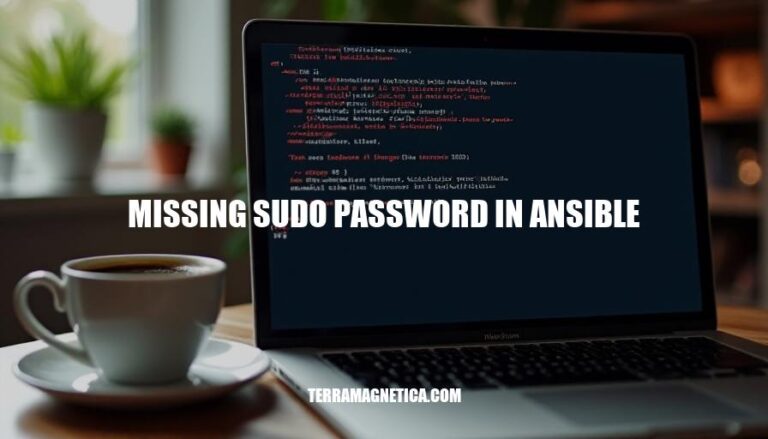


The issue of a “missing sudo password” in Ansible arises when the automation tool cannot execute tasks requiring elevated privileges due to the absence of a sudo password. This is significant because it can halt automation workflows, especially in scenarios where administrative tasks need to be performed on remote servers. Common situations include deploying software, managing system configurations, or running maintenance scripts, where the lack of a sudo password prevents Ansible from completing its operations successfully.
Here are the various reasons why the ‘missing sudo password in Ansible’ error might occur:
Incorrect sudoers file configuration:
NOPASSWD directive for the user or group.Missing password entries:
sudo_pass variable is not defined in the Ansible configuration file or playbook.Insufficient sudo privileges:
ALL keyword in their sudoers entry, limiting their sudo capabilities.Incorrect playbook configuration:
become directive or the -K option to prompt for a sudo password.System-specific issues:
sudo command is not installed on the target system.sudo or equivalent group on the target system.Here’s a step-by-step guide to troubleshoot the ‘missing sudo password in Ansible’ error:
Check User Permissions:
sudo or wheel group:sudo usermod -aG sudo <username>
Edit the Sudoers File:
visudo:sudo visudo
<username> ALL=(ALL) NOPASSWD: ALL
%sudo ALL=(ALL) NOPASSWD: ALL
Run Ansible Playbook with Sudo Password:
--ask-become-pass or -K flag to prompt for the sudo password:ansible-playbook playbook.yml -i inventory.ini --ask-become-pass
Specify Sudo Password in Playbook:
ansible_become_pass variable in your inventory file or playbook:- hosts: all
become: yes
vars:
ansible_become_pass: "your_sudo_password"
Verify Sudo Configuration:
sudo visudo -c
Check Ansible Configuration:
become and become_method are correctly set in your playbook:- hosts: all
become: yes
become_method: sudo
Following these steps should help resolve the ‘missing sudo password’ error in Ansible.
Here are the methods to fix the ‘missing sudo password in Ansible’ error:
Set a Sudo Password:
-K flag to prompt for the sudo password:ansible-playbook playbook.yml -K
Modify the Sudoers File for Passwordless Sudo:
visudo:sudo visudo
your_username ALL=(ALL) NOPASSWD: ALL
wheel):%wheel ALL=(ALL) NOPASSWD: ALL
These methods should help resolve the error.
To prevent the ‘missing sudo password’ issue in Ansible, follow these best practices:
Use Ansible Vault: Encrypt sensitive data, such as sudo passwords, to keep them secure. This prevents plain text exposure and enhances security.
Password Managers: Utilize password managers to store and manage sudo passwords securely. This ensures passwords are not forgotten or misplaced.
Privileged Users: Run playbooks with users who have the necessary privileges. This reduces the need for frequent sudo password prompts.
Sudoers Configuration: Configure the sudoers file to allow specific commands without a password. Use visudo to edit the file and add lines like %wheel ALL=(ALL) NOPASSWD: ALL for trusted users.
Prompt for Passwords: Use the --ask-become-pass (or -K) flag with ansible-playbook to prompt for the sudo password at runtime. This ensures the password is provided when needed.
Separate Sudoers File: Create a separate sudoers file for Ansible tasks to manage permissions more granularly and securely.
Implementing these practices will help maintain secure and efficient Ansible operations.
Follow these steps:
`sudo visudo -c`.become and become_method are set to yes and sudo, respectively, in your playbook.-K flag to prompt for the sudo password.Alternatively, modify the sudoers file for passwordless sudo by:
visudo.`your_username ALL=(ALL) NOPASSWD: ALL` or `%wheel ALL=(ALL) NOPASSWD: ALL` to allow passwordless sudo for a specific user or group.To prevent this issue in Ansible, follow best practices such as:
--ask-become-pass flag.Implementing these practices will help maintain secure and efficient Ansible operations.